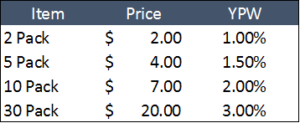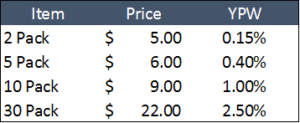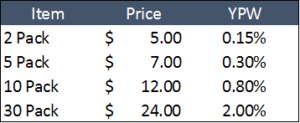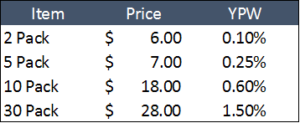FOMC Primer – Moving Out the Charmin Curve
Buckle up kiddos, it’s going to be one of those newsletters…
Last Week This Morning
- 10 Year Treasury back down to 0.90%
- German bund at -0.64%
- 2 Year Treasury down to 0.11%
- LIBOR at 0.16%
- SOFR is 0.08%
- Pfizer received emergency approval and the first vaccines have been shipped
- Continued disagreement on a stimulus package pushed rates lower over the week
- Core CPI 1.6% vs forecasted 1.5%
- Core PPI 1.4% vs forecasted 1.5%
- Wondering where all the “you watch, this virus will magically disappear the day after the election” crowd is right now?
- University of Michigan 1 year forward inflation expectations at 2.3%, which is about the same as the odds that Jim Harbaugh is still the coach next year
- LSU’s self-imposed bowl ban is like my self-imposed slam dunk ban
FOMC Primer – Moving Out the Charmin Curve
There’s only one big change expected to come out of Wednesday’s FOMC meeting – extending the duration of the QE bond purchases. While it might be one of the most boring announcements, the impact is significant.
The Fed is going to keep a lid on long term yields.
The Fed is buying up $80B per month right now. The amount is unlikely to change, but we expect the Fed to adjust the composition of those purchases. By pushing out the duration of the average purchases, the Fed manipulates controls the longer-end of the curve. The real-world impact is that it artificially holds rates low.
With another round of quarantine descending upon us, there’s another run on toilet paper. Let’s use that to help illustrate a point about QE. Like Treasurys, there’s some minimum amount of toilet paper that needs to be purchased each month. Also, given its vital role in daily life, there’s effectively inelastic demand. Unlike toilet paper, however, Treasurys shouldn’t be used to clean up the mess in Lincoln Financial this year unless it’s to pay Howie to go away.
Let’s pretend you are a toilet paper trader. Your life long aspiration come true.
You typically buy 100 rolls of toilet paper each month, some for actual use and some to resell. You spread out your inventory and diversify your risk by purchasing differently sized packages. Think of this as the Charmin curve. Obviously, Yield Per Wipe (YPW) moves inversely to price.

When grocery stores sell out, you step in and sell the toilet paper at a tidy little profit. Maybe the kid fresh out of college only needs a 2 pack, while the family of seven that failed to adequately prepare for the toilet paper apocalypse needs the 30 pack. You develop a pretty good feel for how much you need to buy and how much you will sell each month.
Enter Amazon.
Amazon decides it wants to control prices…for our benefit. Amazon is benevolent. Be grateful for Amazon. Amazon only cares about our well-being. There may be other reasons for them doing so, but we don’t talk about those publicly…
Amazon knows it can control the price of toilet paper through supply and demand levers. It begins doing what you are doing, but at scale. It rolls out its new QW (Quantitative Wiping) program and buys up the Charmin supply before it hits the market.
Amazon starts off by focusing on the smaller packs. It dabbles in the larger family packs, but mostly snaps up the 2 packs. The price of 2 packs starts going up dramatically.
It also means that if you can get your hands on a 2 pack, you are willing to overpay because you have a buyer already lined up. Because Amazon is pressing the “buy” button regardless of price, there is little risk in buying a 2 pack because you know you can offload them easily without losing money. It may also mean you don’t sell your current inventory because you want to see how high of a price Amazon is willing to pay.

In pretty short order, it also means there aren’t any new deals to be had in 2 packs. The YPW is basically zero, making it a questionable investment. Amazon has effectively taken control of that market. What do you do? You turn your attention to the other Charmin packs. Don’t fight Amazon, right?
You mostly focus on the 10 and 30 packs. Their prices are up, but much less on a relative basis. Maybe you can find more unprepared families. Or a college apartment. Those kids never think further ahead than the next party.
Are there alternatives to Charmin? Sure, but they aren’t really a perfect substitute. Some tear more easily than Charmin, making them riskier. Some are manufactured in foreign countries and have pesky currency exchange implications. As you dig deeper, some European toilet paper prices are so high that their YPW is actually negative – how is that even possible? Some guy you went to high school with is bragging on Facebook about how he has made a fortune in shitcoin, a digital toilet paper. Maybe you should investigate that?
Rumors start swirling that Amazon is going to move out the Charmin curve. The amount Amazon will spend each month buying toilet paper will increasingly focus on 10 packs. Prices for 10 packs spike in anticipation of this formal shift. Everyone is scrambling to snap up 10 packs, hoping to front run the actual Amazon purchases.
You hold onto your existing inventory to see how high prices might go. Why would you sell when you know the biggest buyer in the world is moving into your market? Why would you sell when you know they will be a buyer at any price for the foreseeable future? YPW’s fall across the Charmin curve as you and everyone else pile into the Amazon trade.

At an elitist conference you weren’t invited to, Bezos casually mentions that Amazon could, if it wanted to, buy every single roll of toilet paper manufactured. He publicly toys with the idea of not allowing YPW to exceed a certain threshold, such as 1.00% on the 10 pack. Prices continue to climb, and the yield per wipe continues to plunge.

You start to follow Bezos on Twitter. You sign up for breaking news alerts. Amazon decides to revisit its strategy every six weeks and will make a formal statement at the conclusion of those meetings. Bloomberg announces an Amazon Toilet Paper Forward Guidance Index. Some knucklehead in Charlotte starts including it in his newsletters.
Then, a well-respected analyst puts out a research piece that suggests the market is flooded with toilet paper. The country is saturated with toilet paper and there’s no justification for current price levels. Prices should fall over the next year as confidence in the toilet paper market returns.
You think, “Maybe I’ll sell a little bit here.” So you do. Someone immediately snatches it up. You made a nice profit! In fact, you weren’t the only one. Prices and YWP bump around a little bit. Maybe the market had been overbought after all…
But now what? To get back into the game, you need to overpay again. And Amazon’s insatiable appetite for toilet paper means the classic supply and demand metrics no longer apply. Maybe the lesson was – don’t sell. What’s your next move? How do you make profit in a world where Amazon is dictating prices?
Because of the vaccine, we won’t be in quarantine a year from now, right? Toilet paper prices (and therefore YPW) will resume normal behaviors then. Maybe it’s too early to front run that trade now, but early next year you’ll be waiting to pounce.
But if you’re thinking that, isn’t there a chance everyone else it thinking that as well? So do you move now to beat them to it? Buy a toilet paper put with Dec 2021 expiry?
Right about then, an Amazon spokesperson says it expects to continue buying Charmin long after the quarantine has ended. When pressed for specifics, the spokesperson is non-committal and ambiguous. He assures us, however, that Amazon is committed to letting prices overshoot for the benefit of everyone. Your confidence about your position a year from now begins to fade.
Complicating matters, Amazon’s Board likes to reshuffle every four years, and Bezos’ seat at the helm is not assured. That puts a wrinkle in your plans. Sure, Bezos is committed to buying Charmin for the foreseeable future, but what if he gets replaced by someone with a different vision? Should you adjust your position to factor in some tiny chance Bezos is replace?
Wait, what? The Board just reshuffled last month? Holy cow, you have to factor that in now. Thankfully, you’re confident the transition process from one board to the next will be a smooth one, so at least you can take that risk off the table…
You woke up this morning and learned Amazon’s final statement of the year is coming out Wednesday. Will it publicly announce a shift in its QW program? What do you do today in anticipation of that? What if they don’t make that shift? What if they stay focused on the 2-5 packs?
What if they do move out the Charmin curve, but by more/less than expected? What if the government injects $3T of burritos into the collective digestive tract of the country? How do you trade this?!?!
In fact, in what scenario do you envision prices falling?
If Amazon is going to be an automatic buyer every single month, how do prices actually go down? What will it take for YPW to climb again? Is there anything other than Amazon stepping back that could cause that? Amazon is distorting the market.
The effect of every word Amazon says is amplified, while classic supply and demand factors are rendered irrelevant.
Your entire 2020 P&L could be flushed away with a single statement. With that in mind, you hunker down, scan every newsfeed for any hints of about Wednesday’s meeting, poised with a trigger finger over the Toilet Paper buy/sell handle. And then you wait…
Welcome to 2020.
Where a newsletter about Federal Reserve monetary policy can be likened to toilet paper.
And your entire P&L can be wiped away with a single statement.
Now, please tell me why toilet paper prices will plunge next year if Amazon is still actively buying.




